Accounts
The Accounts screen is used to maintain Accounts, Invoice Requirements; Payment Types and Accounting Periods (used for Oracle Financials Interface).
Accounts can be created manually using the Accounts screen or they can be created automatically when payments are generated - if the user has been given access to the function.
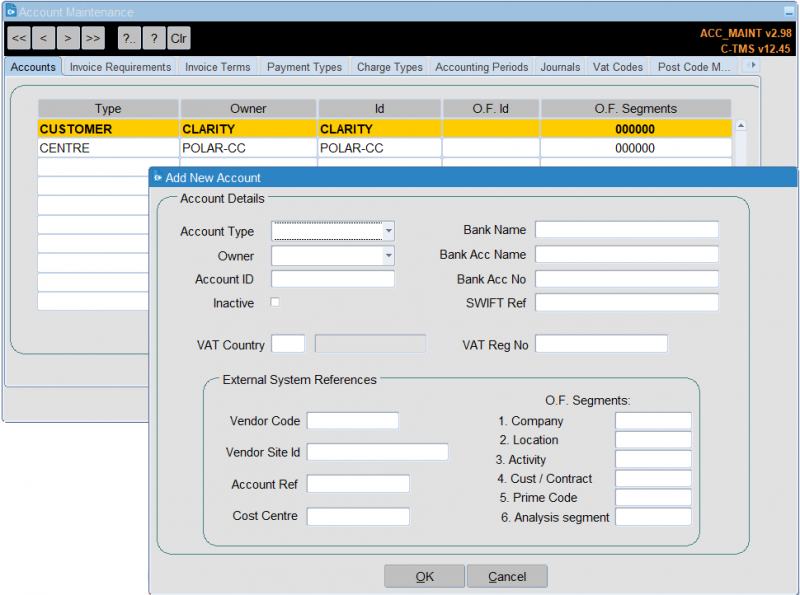
Accounts
An account record needs to be set up for each carrier, customer, and cost centre that is used within the C-TMS System.
![]() Note: Customers added through the Customer Onboarding Interface will have had an account and currency configured for it automatically.
Note: Customers added through the Customer Onboarding Interface will have had an account and currency configured for it automatically.
You must enter the following information to create an account:
- Account Type - one of Customer, Carrier, Centre, Group.
- Owner - the owner of the account, either a Customer, Carrier, Centre, Group, selected from a lookup.
- Account ID - a unique reference to the account.
- Inactive - unchecked for an active account.
You may also enter the following information:
- Bank Name
- Bank Acc Name
- Bank Acc No
- SWIFT Ref
- VAT Country
- VAT Reg No
External System References may also be entered:
- Vendor Code
- Vendor Site ID
- Account Ref
- Cost Centre
- O.F Segments
The OF Segments and OF Id is specific for the interface between C-TMS and Oracle Financials and should be populated if the package is used. The OF segments prompted for will be different depending on the version of Oracle Finance that CTMS has ben configured to use.
Invoice Requirements
Invoice Requirements are used to define the type of invoice that will be created for a customer or carrier and the frequency with which they will be generated. The Debit and Credit accounts are required along with the invoice period - which can be Daily, Weekly or Monthly; this influences how often the invoice is created. Invoices can be generated automatically or manually.
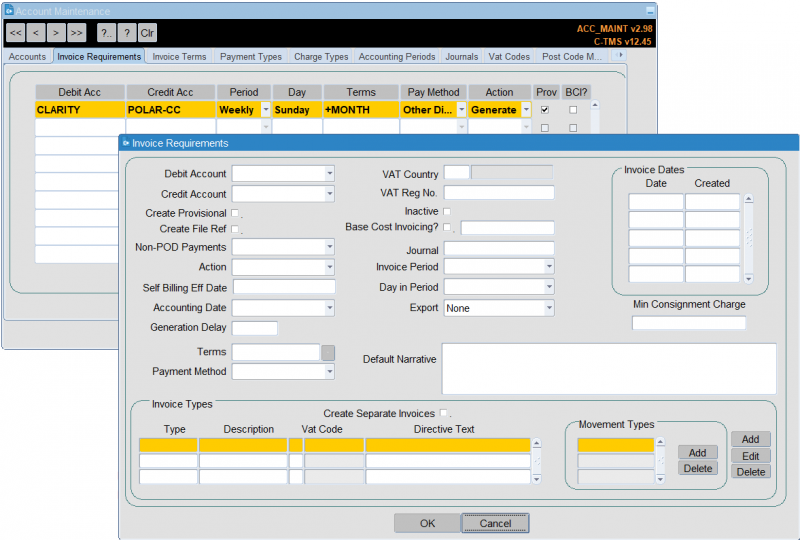
You must enter the following information to create an account:
- Debit Account
- Credit Account
- Inactive - unchecked for an active account.
You may also enter the following information:
- Create Provisional
- Create File Ref
- Non-POD payments
- Action - one of Generate, Manual, Reconcile, Self Bill, Self Bill-Cust
- Self Billing Eff Date
- Accounting Date - one of:
- Approval
- Creation
- Collection
- Delivery
- Order Collection
- Schedule
- Service
- Manual
- Order Delivery
- Generation Delay - a number of days delay in generating the invoice from an approved payment.
- Terms - payment terms, selected from a lookup of payment terms that are maintained in this screen on the Invoice Terms tab.
- Payment Method - one of Cash, Cheque, Credit Card, Direct Debit, Other Directs.
- VAT Country
- VAT Reg No
- Base Cost Invoicing
- Journal - a lookup of available journal numbers.
- Invoice Period - one of Daily, Weekly, Monthly, Date List.
- Day in Period
- Export - an export format from the available values in the drop-down list.
- For an invoice period of Date List, you can maintain the list of dates in the Invoice Dates section of the form.
- Automatically generated Invoices
- If the invoice requirement for a given debit/credit account pair is set to Auto Generate (or self bill in the case of a Carrier), then payments are added to invoices by invoking the Generate Invoices process. This process is done in the invoices form. For Self Bill Carriers a list of completed trips and an Invoice will be emailed to the Carrier at appropriate times. For each invoice that is generated, C-TMS will automatically apply all payments not already invoiced and occurring before the invoice date.
- Manual Invoice Reconciliation
- Manual invoicing is the act of assigning payments to an invoice. This is done via the Trip Debrief form. A Haulier will submit an invoice for payment. The invoice will contain a list of trips that have been undertaken, along with the costs and reference number. Once in the Debrief form, the Hauliers invoice number is used as the key for creating and retrieving invoices. The Bill of Lading is used to select a trip. The information pertaining to the trip is populated, showing the Payment Transactions and order details. If additional payments are required to be added to the invoice then this can be done in this form.
You can also maintain Invoice Types here, in order to create separate invoices per payment type.
Invoice Terms
You can maintain invoice terms here.
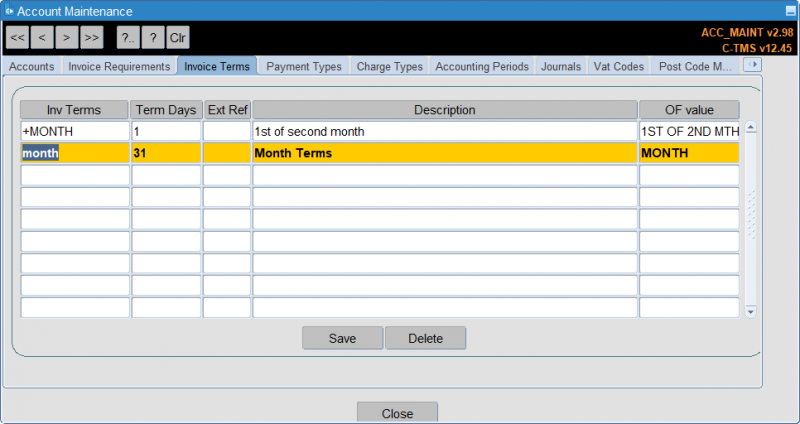
You can enter the following:
- Inv Terms - a unique ID
- Term Days
- Ext Ref
- Description
- OF value - for Oracle Finance.
Payment (Transaction) Types
Every payment must be of a particular payment type.
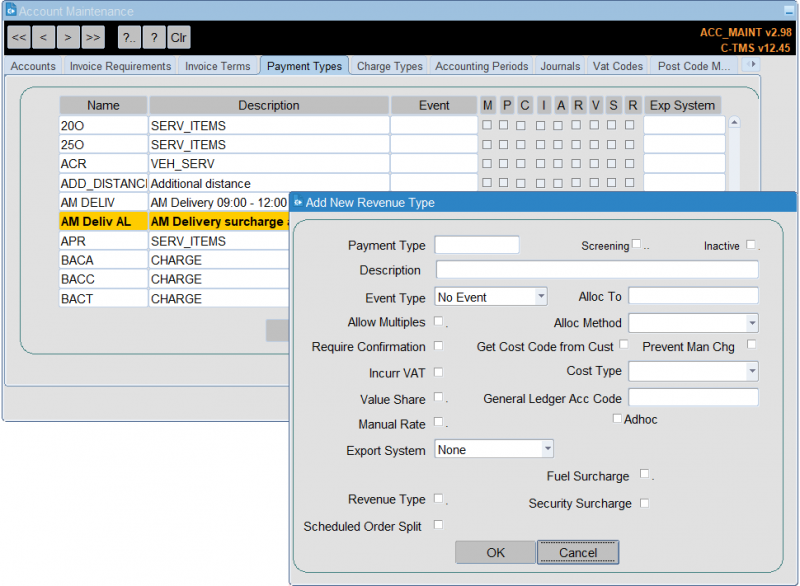
Payment types are configured in the following way:
- Payment Type
- Screening
- Inactive
- Description
- Event Type - This may be set to No Event, Order, Trip, Alloc or blank (miscellaneous).
- Alloc To
- Alloc Method - one of Base Cost, Weight and Distance, RPE and Distance, Specified Order, Specified Customer.
- Allow Multiples: This applies only to payment types that are associated with an event (e.g. ORDER). If not checked, then only one payment of this type will be allowed in respect of the same event.
- Require Confirmation: The status of the payment is forced to be Forecast until some supporting document has been provided.
- Get Cost Code from Cust
- Prevent Man Chg - prevent manual change of payments of this type.
- Incur VAT: Indicates whether the payment will incur VAT.
- Cost Type
- Value Share: Indicates whether the payment type is to appear on the Operation Value reports.
- General Ledger Acc Code
- Manual Rate
- Adhoc
- Export System: At present, payments may only be "exported" to a printer. If this field is set 'PRN', then the payment is marked for export as soon as it is created.
- Fuel Surcharge
- Revenue Type
- Security Surcharge
- Scheduled Order Split
Charge Types
Charge types are how the payments are grouped.
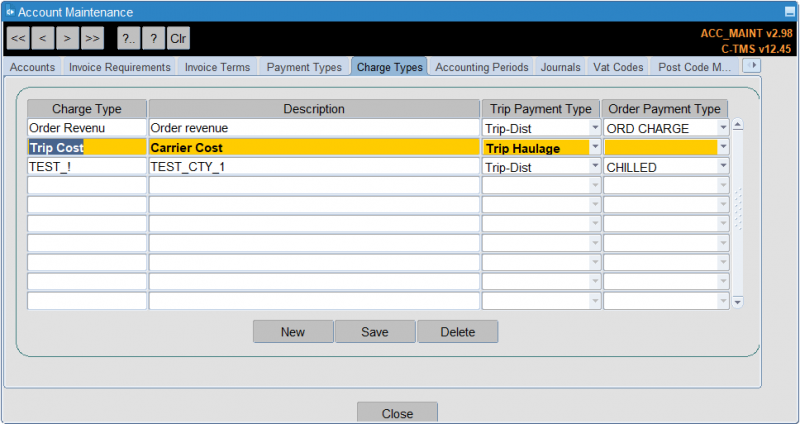
You can enter:
- Charge Type
- Description
- Trip Payment Type - a drop-down list of all trip payment types.
- Order Payment Type - a drop-down list of all order payment types.
Accounting Periods
The interface between Oracle Financials and C-TMS require Accounting Period names to be set up (they need to match exactly those which are used in the package). When a Period is created, the accruals created flag is set to false, this flag is populated by the interface program and indicates which months have had accruals generated and sent to the OF System.
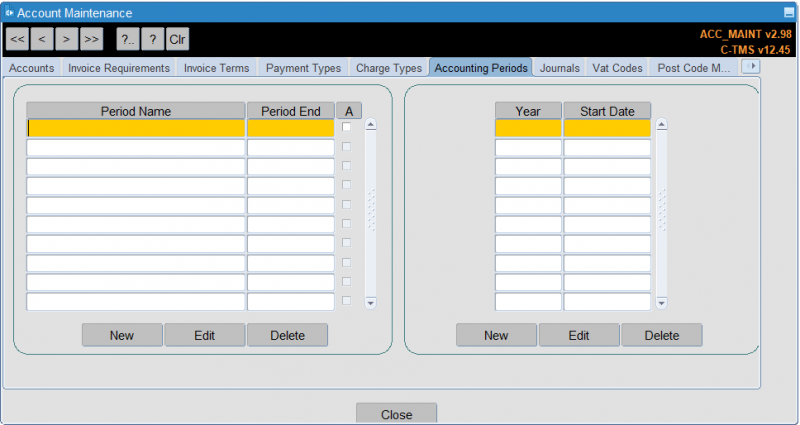
You can enter:
- Period Name
- Period End
- Accruals Created
You can also enter the financial year information:
- Year
- Start Date
Journals
The interface between Exact and C-TMS require journal number. The journal number is set according to the country code of the customer. When an invoice is created, the journal is obtained from the Journals data.
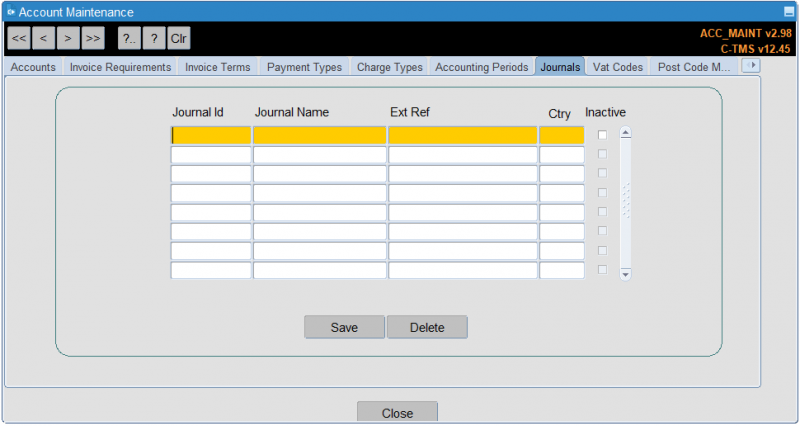
You can enter:
- Journal ID
- Journal Name
- Ext Ref
- Ctry
- Inactive
VAT Codes
VAT codes are used to calculate VAT.
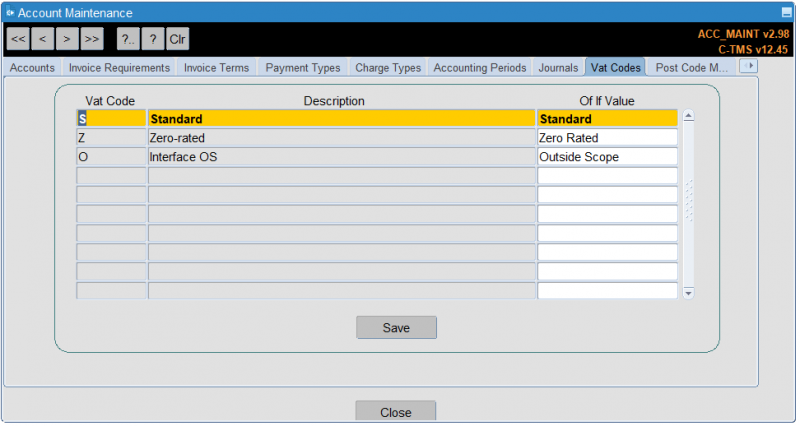
You can enter:
- VAT Code
- Description
- OF IF Value - for Oracle Finance
Post Code Matrix
You can use the Post Code Matrix to define basic charge information for carriers.
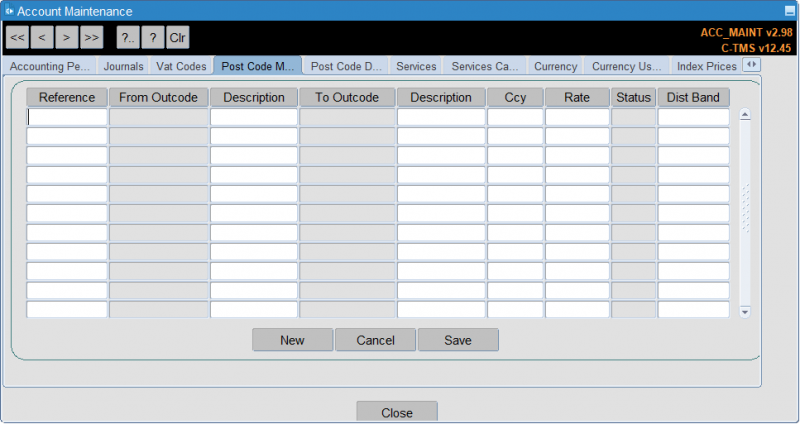
You can enter:
- Reference
- From Outcode
- Description
- To Outcode
- Description
- Ccy
- Rate
- Status
- Dist Band
Post Code Distance
You can use the Post Code Distance to define basic distance information for carriers.
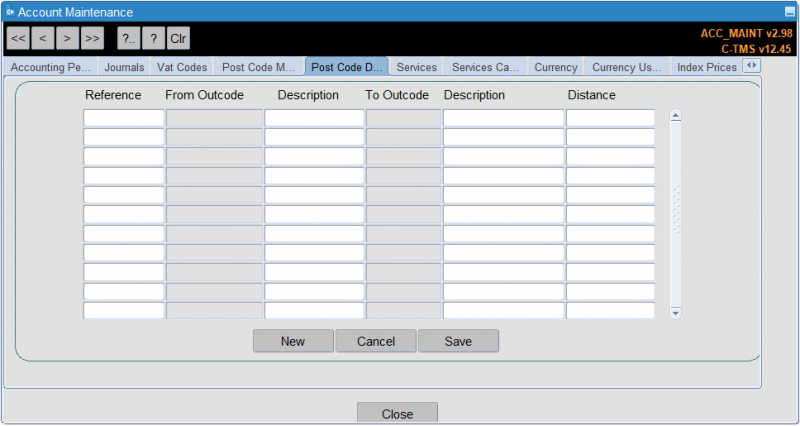
You can enter:
- Reference
- From Outcode
- Description
- To Outcode
- Description
- Distance
Services
Services are additional services against a trip (incurring cost) or against an order (incurring revenue). You can maintain the basic services of all types here.
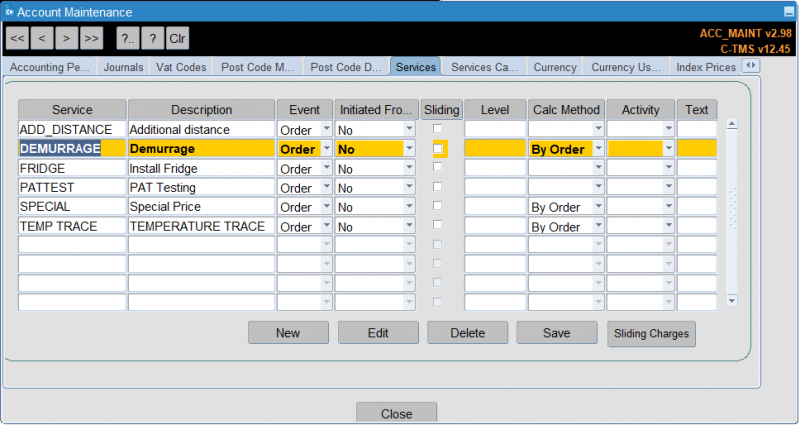
You can enter:
- Service
- Description
- Event - one of Trip, Order, Both, Contract.
- Initiated From
- Sliding
- Level
- Calc Method - one of By Order, By Stop, By Delivery Stop, By Trip.
- Activity one of Load, Unload or Blank.
- Text
You can enter sliding charges against appropriate services:
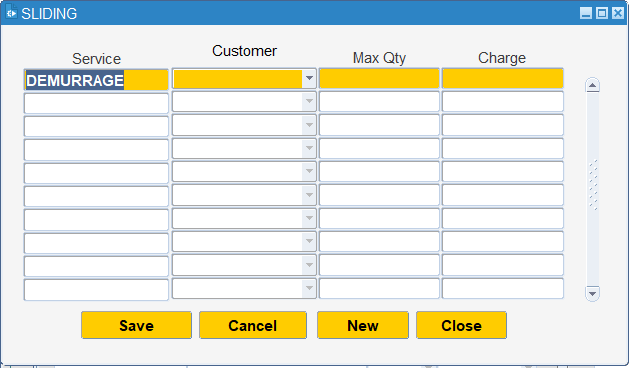
Services Capture
You can enter charges captured against services here.
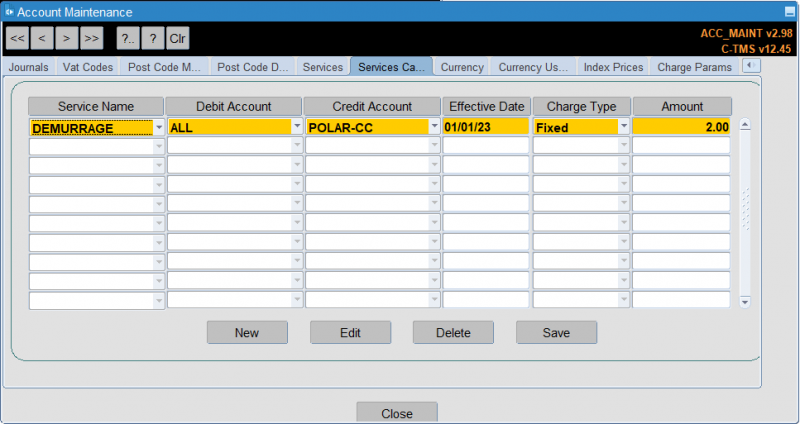
You can enter:
- Service Name
- Debit Account
- Credit Account
- Effective Date
- Charge Type
- Amount
Currency
You can enter system currencies here.
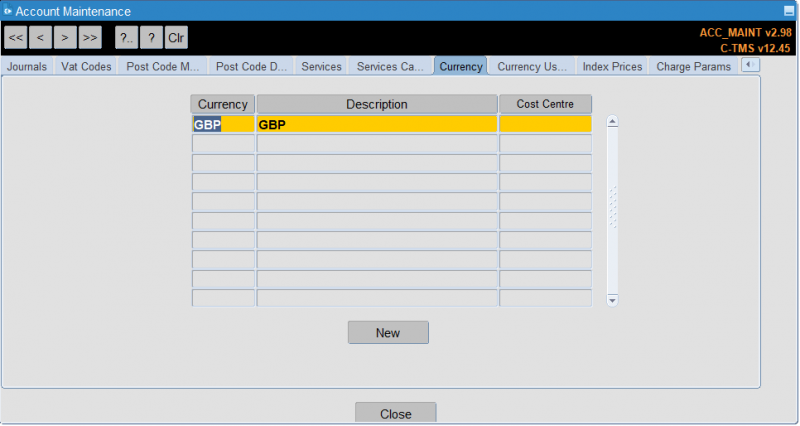
You can enter:
- Currency
- Description
- Cost Centre
Currency Usage
You can enter the currency usage of various parties here. You must have a currency usage for a party to geenrate costs and revency. Further, there must be a common currency between the parties.
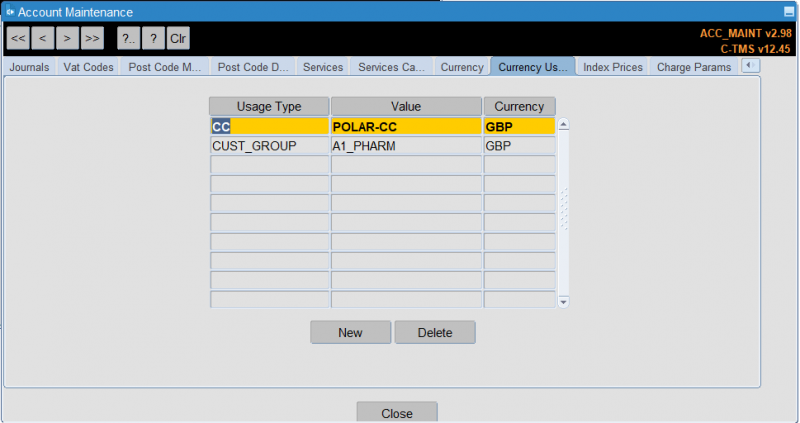
You can enter:
- Usage Type - one of Customer, Customer Group, Cost Centre, Carrier, Group Name, Party.
- Value - a drop-down list of the types above when selected.
- Currency - a drop-down list of all system currencies.
Index Prices
You can enter index prices here.
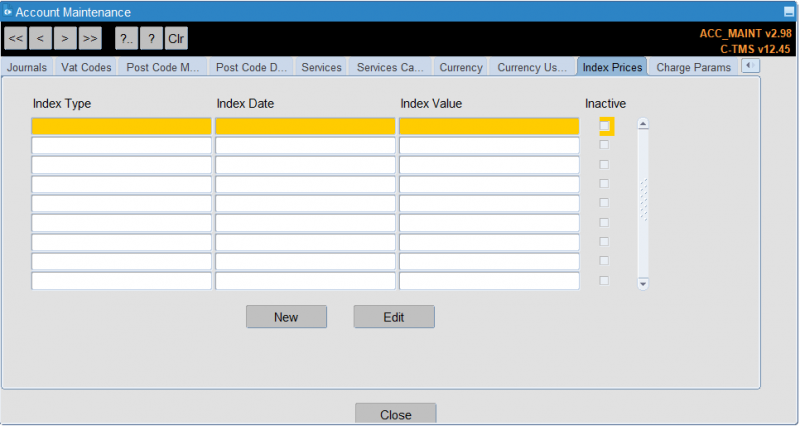
You can enter:
- Index Type
- Index Date
- Index Value
- Inactive
Charge Params
You can enter charge parameters here.
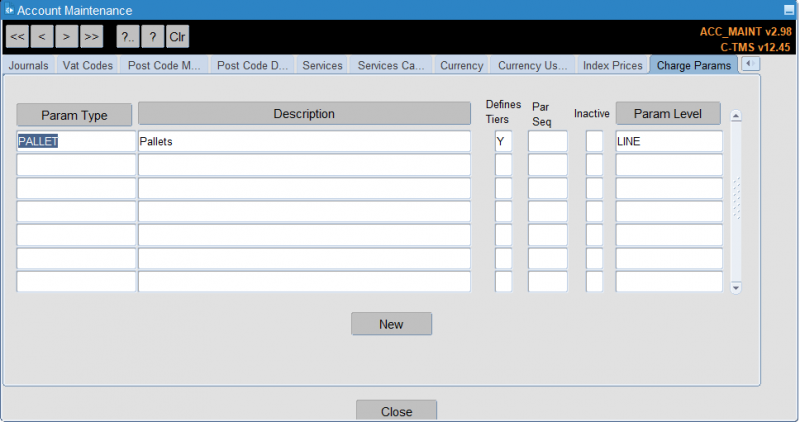
You can enter:
- Param Type
- Description
- Defines Tiers
- Inactive
- Paragon Sequence
- Param Level - one of Line, Header.